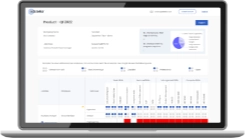
Across industries, companies adopted Agile to escape the weight of slow decisions, rigid hierarchies, and endless sign-offs. The promise was seductive: faster delivery, empowered teams, and customers who actually feel the difference. Yet after the stand-ups end and the dashboards fill with velocity charts, most organizations find that nothing fundamental has changed.
A Boston Consulting Group study found that nearly 70% of Agile transformations fail to meet their objectives. A TransformXperience analysis pushed the insight further: 84% of large enterprises either abandon or lose momentum within 18 months of launching their Agile programs. Those numbers don’t expose a tooling problem. They expose a cultural one.
Agile fails not in the sprint, but in the system around it, the budgeting that still funds projects annually, the leaders who still demand certainty, the managers who still hold approval power, and the fear that still punishes honest failure. When those legacies remain, no framework, no Scrum board, no daily stand-up can save the transformation.
As former Ford president Mark Fields once said:
His words describe exactly what plays out inside most enterprises today: new rituals layered over old mindsets.
This article unpacks why that happens, why culture repeatedly blocks the promise of agility, and what specific shifts in governance, funding, leadership behavior, and measurement can turn Agile from a management trend into a durable operating model that delivers real business outcomes.
Why Agile Transformations Fail: How to Overcome
Most Agile programs don’t fail because the framework is wrong; they fail because the organization around it never changes. Before fixing the process, you must first uncover the system issues. The following sections outline the root causes of Agile failure, from leadership inertia and misaligned governance to skill gaps and flawed metrics, and explain what must change in mindset, structure, and measurement for Agile to truly work.

1. Treating Agile as a Process
Agile often fails not because teams reject it, but because organizations mistake adoption for transformation. They run sprints, retros, and daily stand-ups yet never change how decisions are made, budgets are set, or success is measured.
A Boston Consulting Group study of 127 companies found that 94% had launched Agile initiatives, and two-thirds claimed success. But only 53% actually achieved their transformation goals; the rest were “operating under the illusion of agility”, adopting rituals without changing culture, collaboration, or accountability.
That illusion persists because organizations treat Agile as a process checklist instead of a mindset shift.
Build an Agile Mindset:
True agility begins when leadership rewires how the system itself works:
- Shift Funding: Move from annual project budgets to quarterly outcome-based funding that rewards learning and adaptability.
- Clarify Decision Rights: Define what teams can approve without escalation to reduce bottlenecks and foster ownership.
- Replace Control Gates with Guardrails: Use policy boundaries to manage risk while allowing teams to make fast, autonomous decisions.
Act on Retrospectives: Turn team feedback into real process or policy changes — not just meeting notes.
When leaders are measured by how quickly they remove blockers and teams act within clear boundaries, Agile stops being a set of ceremonies and becomes the organization’s default operating model.
Key Metrics to Watch:
When Agile becomes a true mindset, you’ll see it in the speed of action.
- Decision Latency: How long it takes for a team to get a “yes” or “no.” Aim for under 48 hours on key decisions.
- Lead Time for Change: The time from idea to implemented change. Target a 30% reduction within two quarters.
If these numbers move in the right direction, it means the organization isn’t just doing Agile, it’s thinking and operating Agile.
2. Stagnant leadership
Executives often demand certainty and control, detailed plans, fixed budgets, and risk approvals. When this behavior persists, teams realize little has changed. Decisions still flow top-down, and experimentation feels unsafe. Agile transformation stalls not because the framework is wrong, but because leadership behavior hasn’t evolved with it. Without Agile leadership, the kind that prioritizes trust, adaptability, and empowerment, agility cannot take root.
Model Agile Behaviors:
To break this cycle, leaders must model the behaviors they want the organization to adopt. Agile transformation starts at the top, not in the teams. Leaders shape how decisions are made, how trust is built, and how learning happens. To enable true agility, they need to model the very principles they expect teams to adopt.
- Lead from the Frontline: Join team reviews and retrospectives regularly, not to inspect, but to understand challenges and remove blockers within fixed timeframes. Presence builds trust and accelerates flow.
- Redefine Success: Update executive scorecards to track agility, not activity, measuring decision latency, impediment clearance, and outcome-based funding shifts.
- Shift Decision Power: Clearly define what teams can decide without escalation. Leaders who coach rather than gatekeep create speed and ownership.
- Fund Outcomes, not Tasks: Move from annual project budgets to quarterly, outcome-based funding tied to OKRs. Leaders approve the destination, not every step.
- Model Transparency: Hold blameless postmortems after major issues and communicate what changed as a result. Admitting mistakes at the top normalizes learning everywhere else.
3. Middle Management Resistance to Change
Middle managers often become the friction point in Agile transformation, not because they reject change, but because their roles lose definition. The familiar anchors of authority, approval, and control fade, yet nothing clearly replaces them. What once made them valuable, providing information and validating progress, no longer fits an Agile model built on autonomy and fast learning.
Gallup’s study shows that managers account for about 70% of the variance in team engagement, making their behavior one of the strongest predictors of transformation success. When this group feels uncertain or excluded, their hesitation cascades through teams and quietly stalls change.
Redefine Roles and Incentives
To regain momentum, organizations must rewrite the managerial playbook, transforming managers from supervisors into enablers of flow and capability.
- Redefine the Role: Publish a clear charter with four pillars: Coach, Connector, Capability Builder, and Custodian. Managers focus on developing autonomy, clearing dependencies, building team skills, and protecting compliance boundaries without micromanagement.
- Realign Incentives: Shift scorecards from oversight to outcomes. Reward managers for team performance, flow efficiency, and capability growth, not individual control.
- Reskill the Layer: Provide targeted coaching in systems thinking, facilitation, and data-driven decision making.
- Rebuild Career Paths: Tie advancement to how effectively managers enable others, not the size of their headcount.
Key Metrics to Track:
- Dependency wait time ↓ 40% within two quarters
- Lead time for change ↓ 30%
- Retro action closure ≥ 80% per sprint
- Manager 360 “enables autonomy” ≥ 75%
- New-hire time-to-productivity ↓ 25%
4. Misaligned Teams and Departments
Agile teams move in short cycles and expect fast feedback. Finance, procurement, legal, and risk still run on annual plans, fixed contracts, and long approvals. Work ships in two weeks, but purchase orders, budget gates, and legal reviews take months. The blockage is not in the teams. It is in the wiring. Effective Agile team development depends on how well these systems are aligned to support speed, iteration, and autonomy.
Align Systems and Governance
Redesign the operating system around the teams, not the other way around.
- Governance: Replace milestone sign-offs with policy guardrails. Define risk thresholds, data standards, and security checks that teams can self-serve. Keep only a few true stop gates.
- Funding: Move to quarterly, outcome-based budgets tied to OKRs. Reallocate funds based on evidence every quarter instead of locking scope for a year.
- Procurement: Use iterative contracts and pre-approved vendor frameworks that support incremental delivery, options, and small batch purchases.
- Legal and Risk: Publish lightweight templates and tiered review SLAs. Pre-clear common changes. Reserve full legal review for high-risk items.
- Architecture and Platforms: Build paved roads for CI/CD, observability, and compliance so teams can deploy without one-off approvals.
- Accountability: Make cross-functional leads jointly accountable for outcomes, not just their function’s compliance.
Key Metrics to Track
- Budget approval cycle time cut by 50%
- Procurement turnaround under 10 business days
- At least 25% of funding is reallocated each quarter based on outcomes
- Cross-team dependency wait time down 40%
- At least 70% of work is shipped on paved road platforms
If these numbers move, you fixed the system. If they do not, you are still asking agile teams to run on a waterfall chassis.
5. Fear of Failure
Agile thrives on experimentation, but most organizations still punish failure. Employees quickly learn that mistakes invite blame, not learning, and innovation shuts down. Teams stop taking risks, leaders stop hearing the truth, and retrospectives become performance reviews instead of discovery sessions.
Research supports this pattern. A study of 236 software teams in Norway found that psychological safety has a direct, positive impact on performance, particularly when teams have autonomy and clear roles. Another study showed that Agile teams with higher psychological safety are more likely to admit mistakes and take initiative, resulting in higher-quality outcomes and faster improvement cycles.
Create Psychological Safety
Agility cannot survive without trust. Building it requires deliberate, visible behavior from leaders and consistent reinforcement across teams.
- Model Vulnerability: Leaders must go first, share failures, discuss what they learned, and make it normal to talk about mistakes openly.
- Run Blameless Postmortems: Focus on causes, not culprits. Turn every issue into a process or policy insight that benefits the whole system.
- Encourage Open Retrospectives: Ask, “What’s slowing us down?” rather than “Who missed the mark?” Honest conversation builds collective ownership.
- Reward Learning, not Perfection: Recognize teams that experiment responsibly and surface insights early, even when results fall short.
- Build Feedback Loops: Make feedback part of everyday work through one-on-ones, team health checks, and lightweight surveys that gauge safety and trust.
Over time, these practices transform fear into fuel, the energy that drives continuous learning and real agility.
Key Metrics to Track:
- Psychological Safety Index: ≥ 80% of team members report feeling safe to speak up.
- Experiment Adoption Rate: ≥ 25% of initiatives tested per quarter.
- Retrospective Participation: ≥ 90% of team members actively contributing.
- Defect Discovery in Retros: ↑ 20% within two quarters (indicator of open learning culture).
6. Agile Limited to Pilots
Many organizations launch Agile with one or two pilot teams and expect success to spread on its own. It rarely does. The pilots deliver value quickly, but the rest of the organization still runs on slow governance, rigid funding, and siloed functions. The result: isolated excellence and systemic inertia.
According to Digital.ai’s 17th State of Agile Report, 71% of organizations use Agile in their software delivery lifecycle, yet most admit their initiatives aren’t scaling effectively. The reasons are predictable: leadership misunderstanding, inconsistent practices, and unchanged operating systems that keep the rest of the business moving at waterfall speed.
Scale It Across the Organization
Scaling Agile requires more than adding teams; it means rewiring the enterprise for a continuous flow of value.
- Adopt a Scaling Framework Thoughtfully: Models like SAFe (Scaled Agile Framework), LeSS (Large-Scale Scrum), or Spotify-inspired structures can bring alignment without killing flexibility. Choose one that fits your size, complexity, and governance maturity.
- Standardize the Essentials: Keep a shared cadence for planning, reviews, and retrospectives across teams to synchronize delivery while allowing autonomy within each squad.
- Align Governance and Funding: Move from project-based approvals to portfolio-level outcome funding. Empower product owners to shift priorities without bureaucratic delays.
- Enable Cross-Functional Flow: Integrate finance, legal, and operations into Agile planning so dependencies don’t stall delivery.
- Invest in Enablement: Build internal Agile coaching networks and communities of practice to sustain learning and guard against regression.
When governance, funding, and culture scale alongside delivery, Agile stops being a pilot and becomes the organization’s default operating rhythm.
Key Metrics to Track:
- % of Business Units using Agile Practices: ≥ 60% within 12 months
- Cycle Time Variance Across Teams: ↓ 40%
- Cross-Team Dependency Delays: ↓ 35%
- Portfolio Funding Flexibility: ≥ 25% reallocation per quarter
- Employee Engagement in Agile Units: ↑ 15% year-over-year
7. Skill Gaps
Teams may be enthusiastic about Agile, but enthusiasm without capability quickly plateaus. Most organizations train people on frameworks and tools, but neglect the deeper skills that sustain agility, collaboration, critical thinking, and adaptability. As a result, Agile adoption looks busy but rarely matures.
Build a Continuous Learning Culture
Agility isn’t a one-time skill you acquire; it’s a capability you grow. True agility thrives in organizations where learning is constant, embedded, and measurable.
According to The 17th State of Agile Report, 77% of organizations say the IT skills gap has impacted their operations, and 56% identify upskilling and reskilling as their primary strategy to close it.
To sustain Agile, organizations must turn learning into an operating rhythm, not a side initiative.
What to Change
- Map Capability Gaps: Identify where technical, leadership, and behavioral skills limit flow and delivery.
- Redesign Learning Paths: Move from one-off training to continuous, role-based learning journeys.
- Reinforce Through Practice: Embed peer learning, retrospectives, and cross-team mentoring as everyday habits.
- Reward Learning Outcomes: Tie career growth and recognition to skill evolution and contribution to team agility.
Key Metrics to Watch
- Skill proficiency uplift ≥ 25% within two quarters
- Cross-functional collaboration score ↑ 30%
- Learning adoption rate ≥ 80%
- Retro action closure rate ≥ 85%
When learning becomes part of how work gets done, agility stops being a program; it becomes your organization’s default behavior.
8. Measuring the Wrong Metrics
Many Agile programs fail not because of poor execution, but because they measure the wrong things. Teams celebrate higher velocity or more story points delivered, while customers see no real difference in experience or value. This obsession with activity metrics creates the illusion of progress but hides the absence of impact.
McKinsey’s Enterprise Agility research found that successful Agile transformations drive 20–30% improvements in productivity and cost efficiency, but only when organizations measure outcomes such as customer value created, not volume of work delivered.
Focus on Business Outcomes
True agility is measured in value delivered, not work completed. Output metrics describe effort; outcome metrics reveal impact.
- Reframe KPIs: Replace task-based measures (velocity, story count) with outcome indicators such as customer NPS, lead-time to value, and revenue per experiment.
- Establish Baselines: Quantify delivery cycle times, quality, and satisfaction before transformation; improvement means nothing without a starting point.
- Connect Metrics to OKRs: Link every Agile team’s measures directly to business outcomes.
- Automate Visibility: Use dashboards that show how each sprint contributes to strategic goals, not just operational output.
Key Metrics to Watch
- Customer NPS ↑ ≥ 20% within two quarters
- Lead-time to business value ↓ 30%
- Decision-making speed ↑ 25%
- Percentage of metrics tied to OKRs ≥ 80%
When Agile metrics evolve from counting activity to measuring impact, the organization stops “doing Agile” and starts performing as a truly adaptive business system.
Platforms like Edstellar’s Skill Matrix help organizations connect learning outcomes, performance metrics, and business value, ensuring agility translates into measurable enterprise impact.
Conclusion
The biggest lesson from failed Agile transformations is clear: culture determines success. Tools and frameworks can guide behavior, but only culture can sustain it. Organizations that focus solely on structure without nurturing the correct values will always struggle.
Agile thrives in environments that promote trust, learning, and empowerment. Changing processes is easy; changing people’s beliefs takes effort. But once culture and strategy align, the benefits of faster innovation, stronger teams, and happier customers become inevitable.
With intentional leadership, open communication, and a focus on people, organizations can overcome the Agile culture clash and finally realize the promise of true agility. Agile success starts with people, not just processes. Edstellar helps organizations build truly Agile cultures through expert-led training in leadership, collaboration, and team agility.
Frequently Asked Questions
Explore High-impact instructor-led training for your teams.
#On-site #Virtual #GroupTraining #Customized

Bridge the Gap Between Learning & Performance
Turn Your Training Programs Into Revenue Drivers.
Schedule a ConsultationEdstellar Training Catalog
Explore 2000+ industry ready instructor-led training programs.

Coaching that Unlocks Potential
Create dynamic leaders and cohesive teams. Learn more now!


Want to evaluate your team’s skill gaps?
Do a quick Skill gap analysis with Edstellar’s Free Skill Matrix tool

Transform Your L&D Strategy Today
Unlock premium resources, tools, and frameworks designed for HR and learning professionals. Our L&D Hub gives you everything needed to elevate your organization's training approach.
Access L&D Hub Resources.svg)
.svg)



.svg)

.svg)
.svg)
.svg)
.svg)

